 Image search results - "konan" Image search results - "konan" |

Ishibe-juku was the 51st stage/post or shukuba lodging town on the Tokaido Road where even Emperor Meiji once stayed (with an entourage of over 3,000). View from JR Ishibe Station. Ishibe in Konan city is rural, yet it has a few major industries operating.
|
|

Meaning "Long Life Temple," Chojuji's Hondo temple hall is a National Treasure. It belongs to the Tendai Buddhist Sect and one of the Konan Sanzan Temple Trio along with Jorakuji and Zensuiji Temples.Chojuji temple Entrance gate + fall colors.
|
|

A stone's throw from Chojuji Temple, Jorakuji Temple (est. 708) of the Tendai Buddhist Sect boasts two National Treasures with its main hall and three-story pagoda. It is one of the Konan Sanzan Temple Trio accessible by bus from JR Ishibe Station.In the deep-green forest, you can see part of the pagoda's roof.
|
|
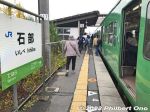
JR Ishibe Station platform.
|
|
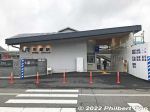
New JR Ishibe Station, Kusatsu Line. New station under construction in late 2022.
|
|

JR Ishibe Station before renovations.
|
|

Fall colors are also nice. Accessible by bus from Ishibe Station or walk from Jorakuji. Path to temple. MAP
|
|

In the deep-green forest, you can see part of the pagoda's roof. You can walk to Jorakuji (means "Constant Comfort Temple") from Chojuji Temple. From Ishibe Station, best to take a bus to Chojuji first, then walk downhill to Jorakuji. Entra
|
|
|
|

San-mon Gate 山門 MAP
|
|

JR Ishibe Station
|
|

Hondo temple hall, National Treasure
|
|

Gate guardian (left side)In the San-mon Gate
|
|

In front of JR Ishibe Station. There are many bicycle garages for out-of-town students who commute from the station to their high school in Ishibe.
|
|

Chojuji temple Hondo temple hall, National Treasure in Konan, Shiga.The hondo once burned down, but was rebuilt during the Kamakura Period.
|
|

Gate guardian (right side)In the San-mon Gate
|
|

Gate in front of Ishibe Station
|
|

Chojuji temple Hondo temple hall, National Treasure
|
|

Path to temple
|
|
|
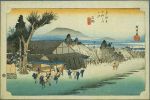
Hiroshige's woodblock print of Ishibe-juku (51st post town on the Tokaido) from his "Fifty-Three Stations of the Tokaido Road" series. A tea house is depicted.
|
|

Hondo temple hall
|
|

Entrance
|
|

Dengaku Chaya tea house reconstructed in 2003 based on Hiroshige's ukiyoe print of Ishibe. A rest place for tourists. Walkable from Ishibe Station. 田楽茶屋The original tea house as seen in Hiroshige's print was located some distance away (nearer to Ritto) from the location of this reconstructed tea house.
|
|
|
|
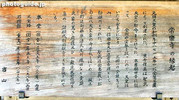
About the templeThe temple was established in 708 as ordered by the emperor.
|
|

Inside reconstructed tea house
|
|
|

Jorakuji Hondo hall, a National Treasure in Konan, Shiga. The pagoda on the left is also a National Treasure. The original temple burned down in 1360, and rebuilt the same year.
|
|

Site of Kojima Honjin and Emperor Meiji marker. The Kojima Honjin was Ishibe-juku's best accommodation suited for feudal lords and emperors.
|
|

Benten-do
|
|

Pagoda and Hondo temple hall
|
|

Ishibe was usually the first overnight stop for travelers going from Kyoto to Edo (Tokyo). The Honjin is no longer in existence, and only a normal house sits on the site.
|
|

Information sign
|
|

Hondo temple hall
|
|

Woodblock print of Ishibe-juku
|
|

Benten-do
|
|

Hondo temple hall
|
|

Entrance to Ameyama Cultural Sports Park, a low hill with various sports and cultural facilities and hiking trails.
|
|

Benten-do
|
|

Entrance to temple hallInside are statues of gods and Buddhas designated as Important Cultural Properties. One of them was stolen, so there are security cameras inside the temple. Photography is also forbidden.
|
|
|

Benten-do
|
|

Temple roof of Jorakuji temple.
|
|

Entrance to Shukuba no Sato, outdoor museum of stage town buildings 宿場の里 MAP
|
|
|

Hondo
|
|
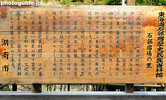
About Shukuba no Sato. Interesting outdoor museum of Edo-Period buildings accurately reconstructed as was found in Ishibe-juku. You can find a farmer's house, merchant's house, inn, tea house, and warehouse. The inside is also quite authentic.
|
|

Pagoda foundationThere used to be a 3-story pagoda, but Oda Nobunaga moved it to his temple. The stone foundations still remain.
|
|
|

Gate 関所
|
|
|

3-story pagoda, also a National Treasure
|
|

Traditional farmer's house 農家
|
|
|

Built in 1400We cannot enter it.
|
|

Traditional farmer's house
|
|

Shrine next to temple
|
|
|

Traditional farmer's house
|
|

Shrine path
|
|
|

Traditional farmer's house
|
|
|

Jorakuji's Three-story pagoda is also a National Treasure Built in 1400.
|
|

Old farming implements (for irrigation)
|
|
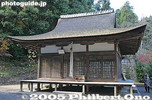
Shrine
|
|
|
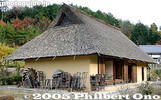
Farmer's house
|
|
|
|

Merchant's house 商家
|
|

Shrine
|
|
|

Merchant's house
|
|

Shrine
|
|
|
|

Inn (hatago) 旅籠
|
|

Shrine
|
|
|

Guest name plates in the inn
|
|
|

Inn
|
|
|

Inn kitchen
|
|
|
|
|

Rice warehouse
|
|
|

Rice warehouse
|
|

Kannon stone buddhaThe temple grounds has 33 stone buddhas.
|
|

Tea house
|
|

Kannon stone buddha
|
|

Tea house
|
|

Fall colors
|
|
|
|

Temple bell
|
|

Old fire truck
|
|

Sansho Shrine 三聖神社The shrine is right next to the temple.
|
|
|
|

Sansho Shrine
|
|

Tokaido History Museum is adjacent to Shukuba no Sato. It explains the 53 stage towns of the Tokaido Road between Edo and Kyoto. 東海道歴史資料館
|
|

Sansho Shrine
|
|

Tokaido History Museum includes an accurate model of Ishibe-juku's palatial Kojima Honjin.
|
|

Ishibe Town logo
|
|

Church house
|
|

Church house
|
|

Ishibe High School. Rare to see a Japanese high school whose name is shown in English.
|
|
|
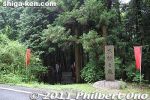
Near the south of JR Mikumo Station (Kusatsu Line) is Fudo-no-taki Waterfall. One of two noted waterfalls in Konan. The waterfall's trail entrance is right along the road, marked by a stone monument. MAP
|
|
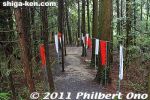
From the road, the path to the waterfall is very short, lined with banners written with the names of ascetic pilgrims who came to pray or practice at the waterfall.
|
|
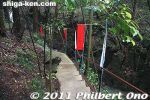
Path going to the waterfall.
|
|
|
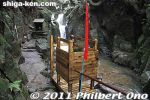
There's even a small lookout deck.
|
|

On the left of the waterfall is a small altar for Fudo-Myo-o, the patron god of mountain ascetic priests. The waterfall takes its name after this god.
|
|

Fudo-no-taki Waterfall in Mikumo, Konan, Shiga Prefecture.
|
|
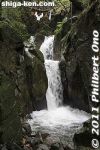
The waterfall is about 5 meters high.
|
|
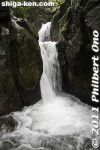
Fudo-no-taki Waterfall in Mikumo, Konan, Shiga Prefecture.
|
|
|

Altar for Fudo-Myo-o.
|
|
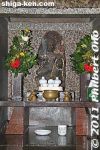
Altar for Fudo-Myo-o.
|
|
|
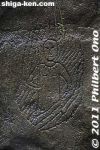
Etching on stone.
|
|
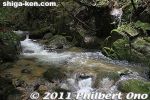
Upstream at the top of the waterfall.
|
|
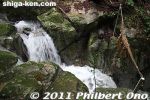
Top of the waterfall.
|
|
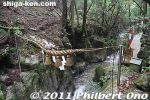
Top of the waterfall.
|
|
|
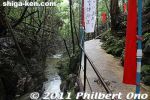
Looking downstream from the waterfall.
|
|

My video of Fudo-no-taki Waterfall in Mikumo, Konan, Shiga Prefecture.
|
|

Konki Senshoku noren curtain. They've been in business in Konan for 200 years. One of three shops left in Shiga doing traditional indigo dyeing with natural (not synthetic) indigo dye. MAPTake a bus or taxi from Kosei or Mikumo Stations on the Kusatsu Line. Get off at Shimoda and walk 50 meters. Parking also available. Phone: 0748-75-0128, Address: Shimoda 1530, Konan-shi, Shiga
|
|

They grow their own indigo plants, dry the leaves in the sun, and extract the dye. They offer indigo dyeing lessons during which you can dye a cotton handkerchief for 1200 yen (T-shirts also). The kind lady first showed us samples of indigo fabrics.
|
|
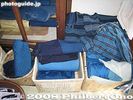
Indigo fabrics for sale. Around 2000 yen per meter. Indigo dyeing came to Shiga from Kyoto. Indigo dyeing is called "aizome" in Japanese. 藍染
|
|
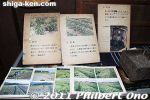
Pictures of their indigo plant farm in Konan.
|
|
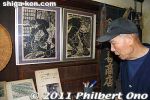
A student created a woodblock print of the indigo artisan dyeing threads.
|
|
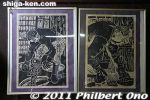
Nice woodblock prints of the indigo master dyeing thread.
|
|
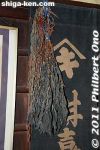
Dried indigo plant.
|
|

Indigo vats.
|
|

So here's the handkerchief (1200 yen). It's very thin cotton. 近江正藍染 <県知事指定・滋賀県伝統的工芸>
|
|

We fold up the handkerchief in whichever way, then tie strings/rubber bands around it. It is tie-dyeing.
|
|

Then we go to the indigo vats. They are heated with charcoal made with wood from trees on their hill. Each vat has a different indigo density.
|
|
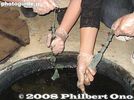
We started with a vat having a low density of indigo. We dip the handkerchief for 15 sec., wring it, then expose it to the air. The indigo dye is actually a murky brownish-yellow color, but turns blue when exposed to the air.
|
|
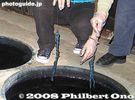
We dipped the handkerchief in multiple vats, each successive vat had a higher density of indigo. The more vats we dip the fabric in, the darker the color.
|
|
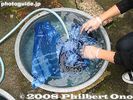
After the indigo dip, water washed the handkerchief.
|
|
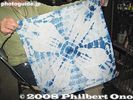
One result... All the designs are unique. We held the wet handkerchief in front of a kerosene heater and it dried quickly.
|
|
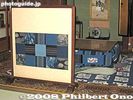
A room inside the shop had indigo fabrics everywhere. It takes years to learn the craft of indigo dyeing, including growing the plants. Like many other traditional crafts, this shop is uncertain who will take over and continue traditional indigo dyeing.
|
|

Indigo placemats on stairs. It's possible for the shop to handle up to 20 people to try indigo dyeing in their shop. Call 0748-75-0128. Address: Shimoda 1530, Konan-shi, Shiga
|
|
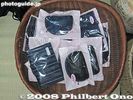
Pouches, etc., made of indigo fabric, for sale. Coming to this place really made me aware of how beautiful the indigo color is. Take a bus or taxi from Kosei or Mikumo Stations on the Kusatsu Line. Get off at Shimoda and walk 50 meters. Parking also avail
|
|

If you go to Konki Senshoku, you might as well also see Shimoda-yaki 下田焼 pottery down the road in the Konan Traditional Crafts Hall (Dento Kogei Kaikan). 湖南市伝統工芸会館 MAP
|
|

Shimoda-yaki is characterized by deep-blue colors on white. They exhibit and sell Shimoda-yaki pottery and also offer pottery lessons. You should make reservations at 0748-72-7444. Take a bus from Mikumo Station and get off at Higashi Iwane 東岩根.
|
|
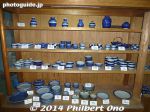
Shimoda-yaki pieces are designed for practical, everyday use.
|
|

Shimoda-yaki started in the 18th century using soil in the Shimoda area of Konan and techniques from Kyoto. Today, only one man makes it, and he has no successor. Pottery lessons cost 3500 yen if you want to make the piece yourself.
|
|
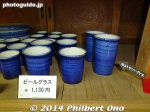
Shimoda-yaki cups
|
|

The hall has a few exhibition rooms.
|
|
|

Next door to the Shimoda-yaki hall is this hall for trying traditional crafts. たくみの家
|
|
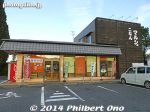
Konan Marché was like a michi-no-eki roadside station. It was a local shop selling local produce, crafts, and souvenirs. It has closed after the new Kocopia shop opened.
|
|
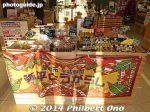
Inside Konan Marché (now closed). Products made of yahei-togarashi hot chili peppers grown in Konan.
|
|
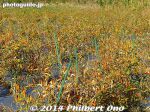
Yahei-togarashi hot chili peppers grown in Konan.
|
|

Yahei-togarashi hot chili peppers are grown in Konan by company called fm craic.
|
|

My video introducing Konan also shows yahei-togarashi hot chili peppers.
|
|
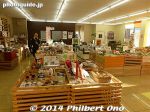
Inside Konan Marché (now closed). A variety of local produce and gifts.
|
|
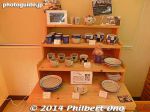
Shimoda-yaki sold by the old Konan Marché (now closed).
|
|
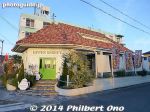
Upper Secret, a popular American-style local cafe specializing in Indian curry with Konan's yahei hot chili peppers and confections. Open 9 am-5:30 pm, closed Tue., Phone: 0748-60-5077Near JR Kosei Station.
|
|
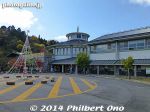
Junibo Onsen Yurara hot spring facility
|
|
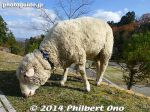
Junibo Onsen Yurara's mascot.
|
|

Nigori-ike Koen Park, local park with a pond noted for cherry blossoms. MAP
|
|

This was 1 or 2 days before the cherries reached full bloom.
|
|
|
|
|
|
|
|
|
|

Painted bench
|
|

Konan has some industrial parks.
|
|
|
|

Rice warehouse in Konan, Shiga.
|
|

JR Mikumo Station on the Kusatsu Line.
|
|

JR Mikumo Station platform
|
|

Manhole in Konan, Shiga.
|
|

Established in the 8th century and one of the Konan Sanzan Trio of Tendai Buddhist National Treasure temples in Konan, Zensuiji's main Hondo Hall is a National Treasure. It is on the slope of Mt. Iwane.Zensuiji means "Efficacious Water Temple." From JR Kosei Station on the JR Kusatsu Line, catch a bus and get off at Iwane 岩根. From there, you still have to walk a bit, follow the signs (if you can read Japanese). This road leads to one entrance to Zensuiji.
|
|

Path up the mountain slope to Zensuiji.
|
|

Sign points the way to Zensuiji.
|
|
|
|

After a wooded path, you will see this.
|
|

This is in early April.
|
|
|
|
|
|
|

If you go by car, this is the large parking lot you will see.
|
|

Zensuiji stone marker.
|
|

Entrance to Zensuiji. Admission 500 yen charged. MAP
|
|

Temple bell on the left. Public is welcome to ring the bell during New Year's Eve.
|
|

And there it is, the National Treasure. Zensuiji's Hondo Hall. Zensuiji worships Yakushi Nyorai (the buddha of healing and medicine).
|
|

Some hillside construction work.
|
|

Zensuiji Hondo Hall in Konan, Shiga. National Treasure.
|
|

Very graceful roof lines.
|
|
|
|
|
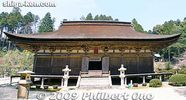
Front view of Zensuiji Hondo Hall. National Treasure. The building design is very similar to Kongorinji temple.
|
|

Unfortunately, photography is not allowed inside. There is also a priest guide inside the Hondo Hall to give you a tour and explanation of the temple in Japanese.
|
|
|
|
|

Temple garden before the cherries reached full bloom.
|
|
|

Zensuiji temple, National Treasure.
|
|
|
|

My video introducing Konan's treasures also shows Zensuiji.
|
|
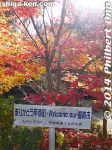
Also visited Zensuiji in autumn. Thought it was more colorful than in spring.
|
|

Red maples greet you as you approach Zensuiji's main hall.
|
|
|
|
|

Zensuiji temple in autumn.
|
|
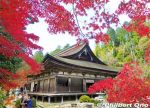
Red maples framing Zensuiji temple in autumn.
|
|
|
|
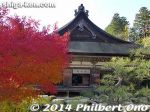
Autumn leaves accent Zensuiji very nicely in autumn.
|
|
|
|
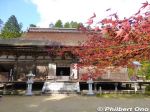
Zensuiji Hondo main worship hall
|
|
|
|
|
|
|
|
|
|
|
|
|
|
|
|
|

Wall
|
|

Zensuiji Hondo main hall
|
|

Zensuiji Hondo main hall
|
|
|
|
|
|
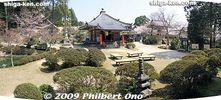
Azalea bushes
|
|
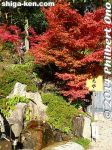
Zensui natural spring water. Donate small change to get a bottle to fill up with this healing water.
|
|

One spring from which the temple got its name. Zensuiji means Efficacious Water Temple.
|
|

One spring from which the temple got its name.
|
|
|

Bell
|
|
|
|
|

Another spring from which the temple got its name.
|
|
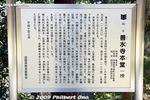
About Zensuiji in Japanese.
|
|
|
|
|
|